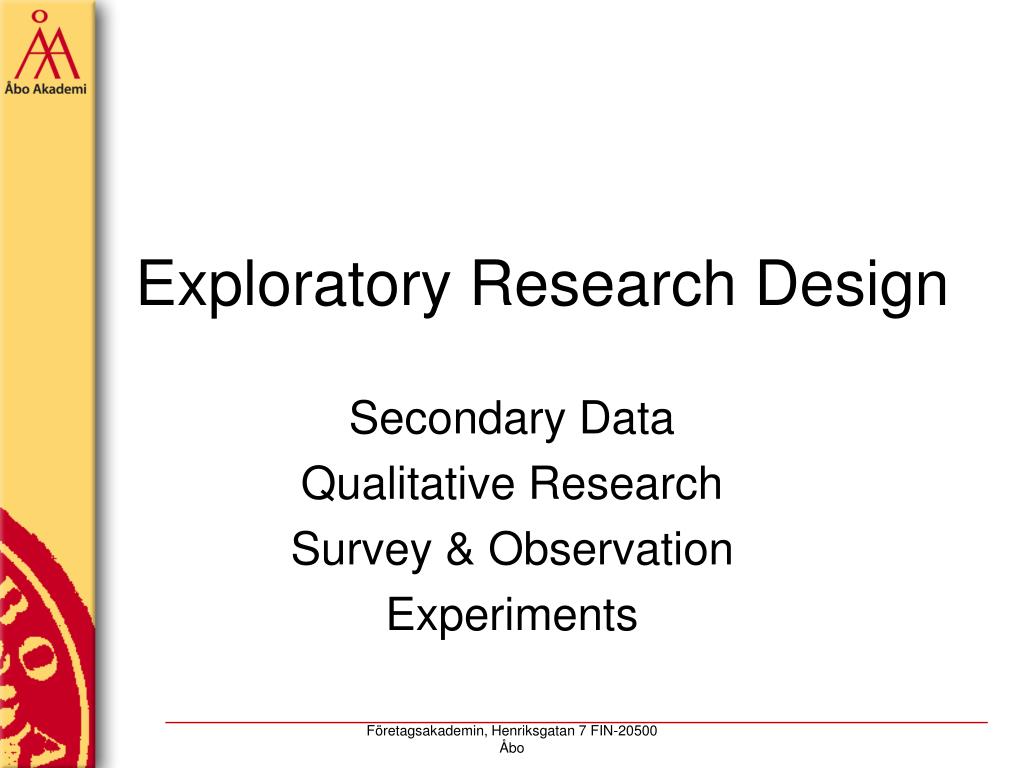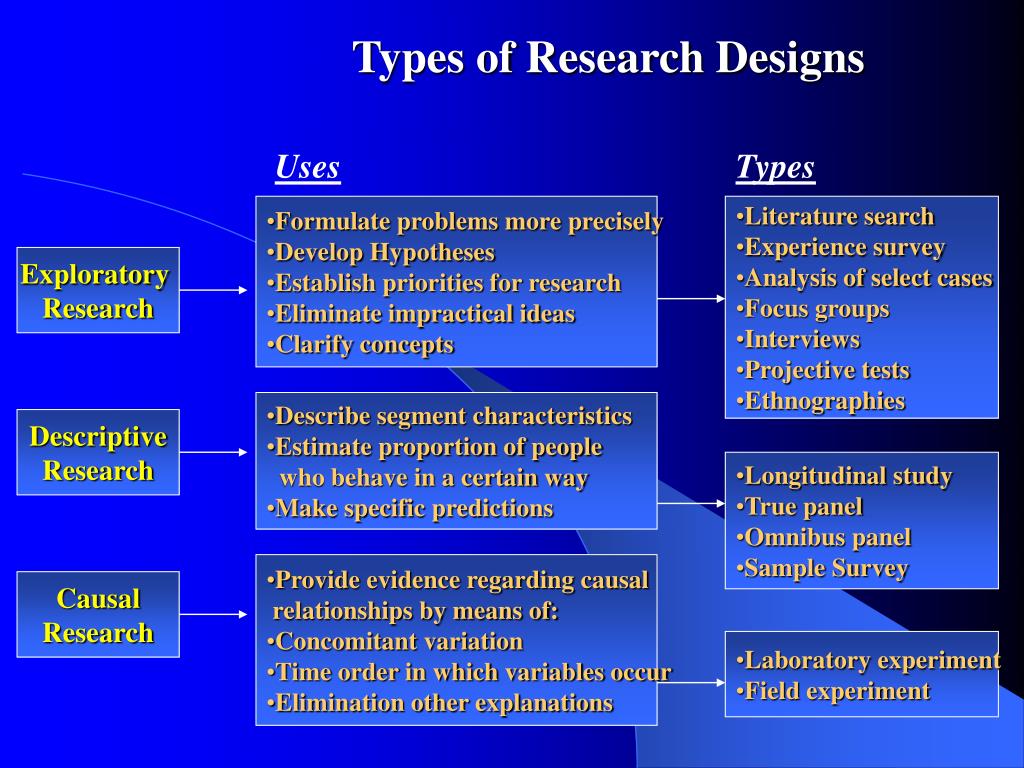Table Of Content

In other words, researchers must understand what research designs are available to best address their research problems and guide them throughout the research process. With new researchers in mind, this article focuses on exploratory research design – its conduct and applications in management sciences. Compared with descriptive or comparative studies, exploratory studies approach the topic of study primarily in an inductive fashion to investigate the areas of potential research interest that remain mostly or wholly unexamined by the scientific community. Investigators undertaking exploratory studies typically have few expectations for what they might find, and their research design and approach may shift dramatically as they learn more about the phenomena of interest. An example of an exploratory study is a study that uses convenience sampling and unstructured interviews to explore what patients think about a new treatment in a single healthcare setting.
Book contents
This could include conducting surveys, hosting focus groups, or one-on-one interviews. Our framework is based on a team-based review of published guidelines and standards discussing the scientific conduct of qualitative health research. In contrast to previous reviews,25 we did not seek to synthesise these guidelines. Rather we drew on them to develop a conceptual framework for designing and informing formal assessments of rigorous qualitative research. It is almost impossible to come up with a research topic that hasn’t been conducted before.
Organizing Your Social Sciences Research Paper
This involves an in-depth analysis of a particular case or situation to gain insights into the underlying causes, processes, and dynamics of the issue under investigation. It can be used to develop a more comprehensive understanding of a complex problem, and to identify potential research questions or hypotheses. The research design establishes the decision-making processes, conceptual structure of investigation, and analytical methods used to address the study’s central research problem (Tegan, 2021). Taking the time to select an appropriate research design will assist researchers in organising their thoughts, define the scope of their study, increase the reliability of their findings, and avoiding misleading or incomplete conclusions. As a result, if any aspect of research design is flawed or misappropriate, the quality and dependability of the results, as well as the overall value of the study, will diminish (Umesh, 2021).
Exploratory Research: Types & Characteristics
The study concluded that knowledge of exploratory research design could help researchers better define, understand research problems, and advance research in management sciences. The study recommended that, researchers should choose research designs that they are most comfortable with and feel most competent to handle, but the choice should ideally be based on the nature of the research phenomenon being studied and information available. PCORI’s own methodological standards have been largely silent regarding qualitative methods until recently,32 leaving applicants without clear direction on how to conduct rigorous qualitative research. Incorporation of tailored qualitative standards could help to clarify and improve the rigour of proposal design, review and completion. The establishment and integration of such standards could also guide journal editors in developing transparent standards for deciding priorities for publication.
Observational Research – Methods and Guide
However, a few things have to be kept in mind while researching from these sources. Government agencies have authentic information but sometimes may come with a nominal cost. Also, research from educational institutions is generally overlooked, but in fact educational institutions carry out more number of research than any other entities. Studentsshould always cross-check any information on this site with their course teacher. Before beginning your paper, you need to decide how you plan to design the study.
New Case Studies
This depends on what is being researched, like a food sampling for a fast food chain or maybe a presentation of potential advertisements for an anti-smoking campaign. Exploratory research is carried out when a topic needs to be understood in depth, especially if it hasn’t been done before. The goal of such a research is to explore the problem and around it and not actually derive a conclusion from it. Such kind of research will enable a researcher to set a strong foundation for exploring his ideas, choosing the right research design and finding variables that actually are important for the in-depth analysis. Most importantly, such a research can help organizations or researchers save up a lot of time and resources, as it will enable the researcher to know if it worth pursuing. Exploratory Research refers to the research methodology used when researchers have a limited understanding of the topic at hand and want to gain a broader perspective or more insights into the subject.
An exploratory research is the research that helps to learn the essence of the problem; to make sure that there is a problem, and to find out the character of this problem. They are carried out in the form of free discussions with experts specially selected for this purpose or analysis of secondary information.The hypotheses of such research are vague or absent at all. At this stage of research, the marketer has a very rough idea of the required information. An exploratory research is conducted when it is necessary to understand the general nature of the problem, identify possible alternatives to the solution, as well as relevant variables that need to be taken into account.
Types and methodologies of Exploratory research
Usually, exploratory research is followed up with explanatory research or research involving more structured tools of data collection. Exploratory research should also have a few theories which can support its findings as that will make it easier for you to evaluate the findings and move ahead with further research. Since exploratory research is looking for new insights, or depth of information, it may be time consuming. One of the most time consuming aspects involves finding the right people to take part in the research and motivating them to share the level of insight you’re looking for.
Are smart cities more sustainable? An exploratory study of 103 U.S. cities - ScienceDirect.com
Are smart cities more sustainable? An exploratory study of 103 U.S. cities.
Posted: Fri, 01 Sep 2023 07:00:00 GMT [source]

Further, it demonstrated the conduct and applications of exploratory research design in management sciences by referring to various articles in this field. Given the diversity of approaches, a foundational step to improving the assessment of rigour in qualitative research is to abandon the attempt to develop a single standard for the best practices regardless of study orientation and objective. These three types reflect differences in primary study objectives and existing knowledge within a topic area.
Information acquired from observational research takes the form of “field notes” that involves documenting what the researcher actually sees and hears while in the field. Findings do not consist of conclusive statements derived from numbers and statistics because field research involves analysis of words and observations of behavior. Conclusions, therefore, are developed from an interpretation of findings that reveal overriding themes, concepts, and ideas. Analysis of management sciences research using an exploratory research design seems to be an intriguing topic for scholars and practitioners due to its positive impact on organisational performance.
This can be helpful in developing new theories or explanations that are supported by the data. This method involves analyzing the relationships and connections between data points. It can be useful in identifying patterns in complex datasets with many interrelated variables.
Furthermore, “an exploratory study may not have as rigorous a methodology as that used in conclusive studies, and sample sizes may be smaller (Nargundkar, 2008). Descriptive studies occupy a middle position, building on previously conducted exploratory work so researchers will be able to proceed with more-focused inquiry. This should include well-defined procedures including sampling protocols and analytical plans, and investigators should usually articulate expected findings prior to beginning the study. However, as researchers investigate phenomena in new settings or patient populations, it is reasonable to expect descriptive studies to generate surprises. Thus, descriptive studies also feature inductive elements to detect unexpected findings, and must be flexible enough in design to accommodate shifts in research focus and methods based on empirical findings. An example of a descriptive study is a longitudinal study of patients with ovarian cancer that employs semistructured interviews and directed content analysis to examine decision-making across patients in a novel setting.
You can gain valuable insights into their behaviors and decision-making processes by interacting directly with your target audience. Explore our customer satisfaction survey templates to rapidly collect data, identify pain points, and improve your customer experience. Other online sources of information include statistical information, the websites of competitors, and social media platforms, where prospective customers might be talking about your products or those like it. Literature research is the process of gathering data from published sources like textbooks, journals, magazines, and the like. This information might be available in hard copy, or you may be able to conduct your research through the Internet. For example, if you want to develop your own sustainability statement, you might gather the annual reports of a few businesses operating in your industry as these reports are usually readily available online.
A longitudinal study follows the same sample over time and makes repeated observations. For example, with longitudinal surveys, the same group of people is interviewed at regular intervals, enabling researchers to track changes over time and to relate them to variables that might explain why the changes occur. Longitudinal research designs describe patterns of change and help establish the direction and magnitude of causal relationships. Measurements are taken on each variable over two or more distinct time periods.

No comments:
Post a Comment